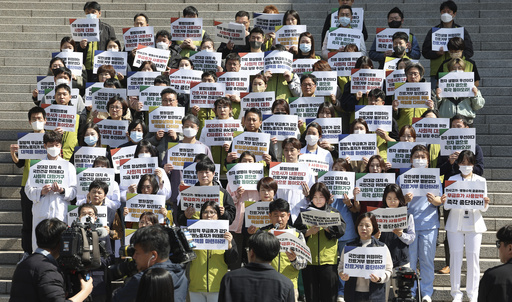SEOUL, South Korea (AP) — South Korea’s president vowed Monday not to back down in the face of vehement protests by doctors seeking to derail his plan to drastically increase medical school admissions, as he called their walkouts “an illegal collective action” that poses “a grave threat to our society.”
About 12,000 medical interns and residents in South Korea have been on strike for six weeks, causing hundreds of cancelled surgeries and other treatments at university hospitals. In support of their action, many senior doctors at their teaching schools have also submitted resignations though they haven’t stopped treating patients.
Officials say they want to raise the yearly medical school cap by 2,000 from the current 3,058 to create more doctors to deal with the country’s rapidly aging population. Doctors counter that schools can’t handle such an abrupt increase in students and that it would eventually hurt the country’s medical services. But critics say doctors, one of the best-paid professions in South Korea, are simply worried that the supply of more doctors would result in lower future incomes.
Public surveys show that a majority of ordinary South Koreans support the government plan. But observers say many people are increasingly fed up with the protracted confrontation between the government and doctors, threatening to deal a blow to governing party candidates ahead of next week’s parliamentary elections.
In a nationally televised address, President Yoon Suk Yeol said adding 2,000 medical students is the minimum increase needed to address a shortage of physicians in rural areas, the military and essential but low-paying professions like pediatrics and emergency departments. Yoon said South Korea’s doctor-to-patient ratio — 2.1 physicians per 1,000 people — is far below the average of 3.7 in the developed world.
“Increasing the number of doctors is a state project that we can’t further delay,” Yoon said.
Yoon urged the striking doctors to return to work, saying they have a responsibility to protect people’s lives in line with the local medical law. He also said the government remains open to talks if doctors come up with a unified proposal that adequately explains their calls for a much smaller increase in the medical school enrollment quota.
“I can’t tolerate an attempt to carry through their thoughts by force without due logic and grounds,” Yoon said. “The illegal collective action by some doctors has become a grave threat to our society.”
Yoon said the recruitment plan won’t lead to lower earnings for doctors, citing what he called expected increases in national income and demand for medical services in the fast-aging society. He said the average income of South Korean doctors is the highest in the developed world.
Later Monday, the Korean Medical Association, which represents doctors in South Korea, criticized Yoon for repeating what his government has already argued to support the recruitment plan.
“It was an address that brought us greater disappointment because we had high hopes” for some changes in the government’s position, Kim Sung-geun, a spokesperson for KMA’s emergency committee, told reporters.
Yoon said the government is taking final administrative steps to suspend the licenses of the strikers but added he doesn’t want to punish the young doctors. This implies that his government is willing to soften punitive measures on the strikers if they return to work soon.
Yoon recently ordered officials to pursue “a flexible measure” to resolve the dispute and seek constructive consultations with doctors at the request of ruling party leader Han Dong-hoon.
It’s unclear if the government and doctors can find a breakthrough to settle their standoff anytime soon. Last week, KMA elected Lim Hyun-taek, a hardliner who has called for a decrease in the medical school admission cap, as its new chief.
After his election Tuesday, Lim said that doctors can sit down for talks with the government if Yoon apologizes and dismisses top health officials involved in the recruitment plan. Lim also threatened to launch an all-out fight if any doctors receive punitive steps over their recent protests.
The striking junior doctors represent a fraction of the total doctors in South Korea — estimated at 115,000 by Yoon and 140,000 by a doctors’ association. But in some major hospitals, they account for about 30% to 40% of doctors, assisting qualified doctors and department chiefs during surgeries and other treatments while training.
Doctors say the government enrollment plan lacks measures to resolve key medical issues such as how to increase the number of physicians in some key but unpopular professions. They say newly recruited students would also try to work in the capital region and in high-paying fields like plastic surgery and dermatology. They say the government plan would also likely result in doctors performing unnecessary treatments due to increased competition.
This website uses cookies so that we can provide you with the best user experience possible. Cookie information is stored in your browser and performs functions such as recognising you when you return to our website and helping our team to understand which sections of the website you find most interesting and useful.
